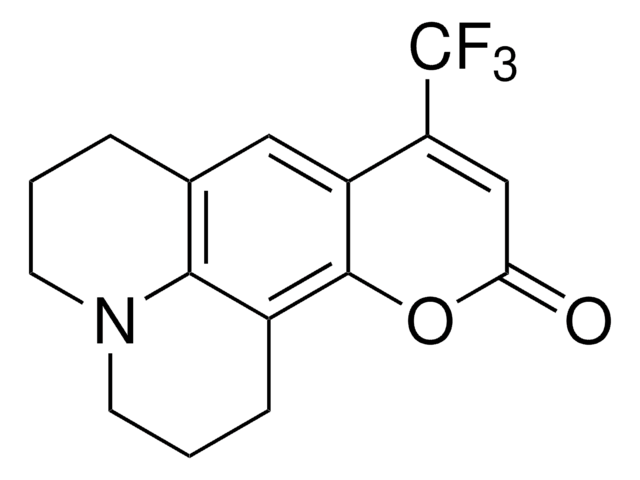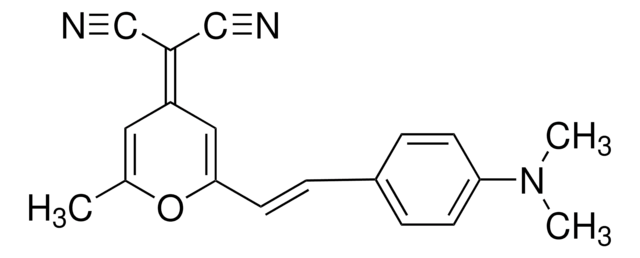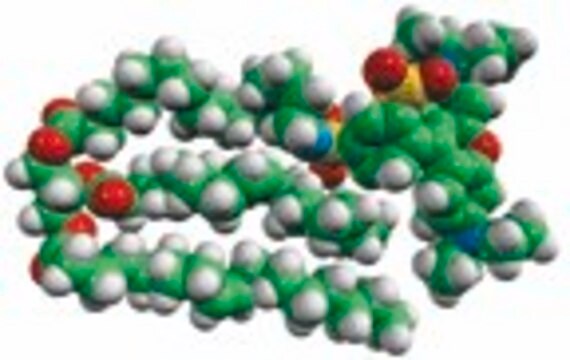Key Documents
442631
Coumarin 6
98%
Synonim(y):
3-(2-Benzothiazolyl)-7-(diethylamino)coumarin, 3-(2-Benzothiazolyl)-N,N-diethylumbelliferylamine
About This Item
Polecane produkty
Poziom jakości
Próba
98%
Postać
solid
mp
208-210 °C (lit.)
λmaks.
444 nm
fluorescencja
λem 505 nm in ethanol (Lasing peak 534 nm, lasing range 515 - 558 nm (DMSO), pump source XeCl (308 nm))
Wydajność urządzenia OLED
ITO/Alq3:Coumarin 6/Mg:Ag
ciąg SMILES
CCN(CC)c1ccc2C=C(C(=O)Oc2c1)c3nc4ccccc4s3
InChI
1S/C20H18N2O2S/c1-3-22(4-2)14-10-9-13-11-15(20(23)24-17(13)12-14)19-21-16-7-5-6-8-18(16)25-19/h5-12H,3-4H2,1-2H3
Klucz InChI
VBVAVBCYMYWNOU-UHFFFAOYSA-N
Szukasz podobnych produktów? Odwiedź Przewodnik dotyczący porównywania produktów
Opis ogólny
Zastosowanie
- in block copolymer (BCP)-based micelle based drug delivery studies in glioma cell lines
- in combination with flufenamic acid (FA) based nanoprodrug uptake in glioma cells
- in poly(lactic-co-glycolic acid) (PLGA) based elvitegravir nanoprodrug uptake studies
Kod klasy składowania
11 - Combustible Solids
Klasa zagrożenia wodnego (WGK)
WGK 3
Temperatura zapłonu (°F)
Not applicable
Temperatura zapłonu (°C)
Not applicable
Środki ochrony indywidualnej
Eyeshields, Gloves, type N95 (US)
Wybierz jedną z najnowszych wersji:
Masz już ten produkt?
Dokumenty związane z niedawno zakupionymi produktami zostały zamieszczone w Bibliotece dokumentów.
Klienci oglądali również te produkty
Produkty
One of the common difficulties with intravenous drug delivery is low solubility of the drug. The requirement for large quantities of saline to dissolve such materials limits their clinical use, and one solution for this problem that has recently generated interest is the formation of drug-loaded micelles.
Developed in the last several years, fluorescence quenching microscopy (FQM) has enabled rapid, inexpensive, and high-fidelity visualization of two-dimensional (2D) materials such as graphene-based sheets and MoS2.
Graphene has emerged as the new wonder material. Being only one atom thick and composed of carbon atoms arranged in a hexagonal honeycomb lattice structure, the interest in this material has exploded exponentially since 2004 when it was first isolated and identified using a very simple method.
Nasz zespół naukowców ma doświadczenie we wszystkich obszarach badań, w tym w naukach przyrodniczych, materiałoznawstwie, syntezie chemicznej, chromatografii, analityce i wielu innych dziedzinach.
Skontaktuj się z zespołem ds. pomocy technicznej










